516-528 N. Milwaukee Avenue - Proctor Building, New Castle Hotel
Introduction
Text-to-speech Audio
Images
The Proctor Building, circa 2016
.jpg)
The Grove Hotel, circa 1865
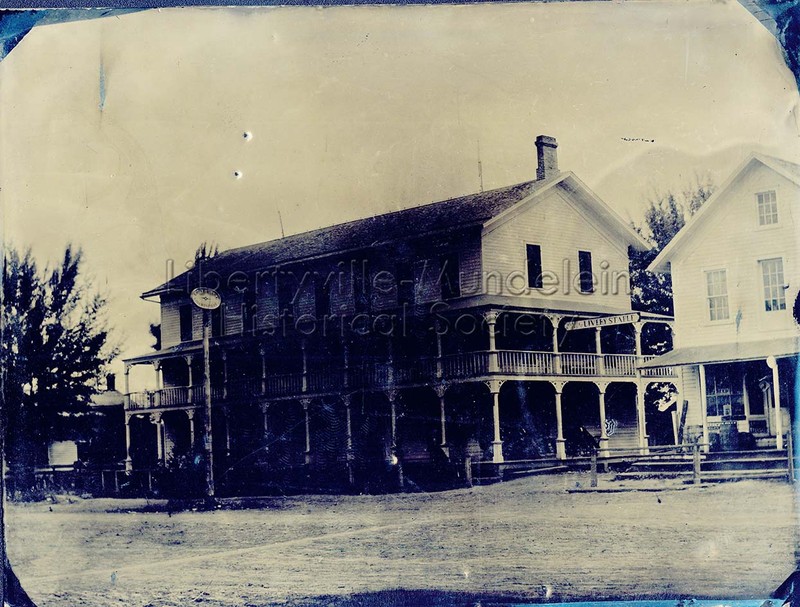
The Proctor Building, 1905-1913
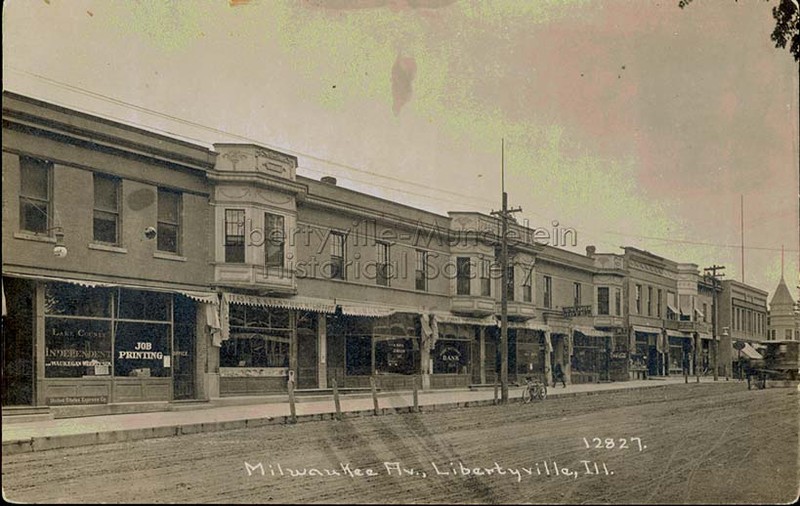
Looking north on Milwaukee Avenue, 1923. Proctor Building is on the right.
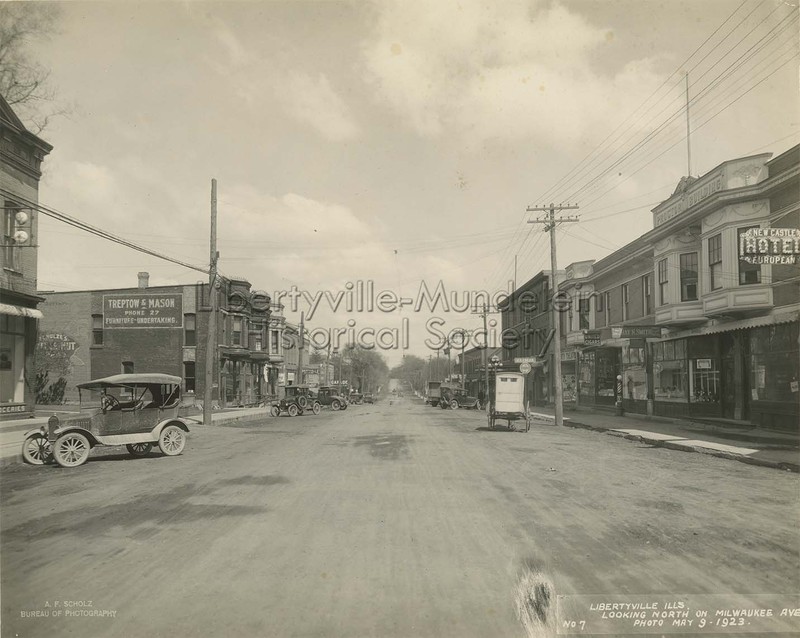
Factor's, 1957
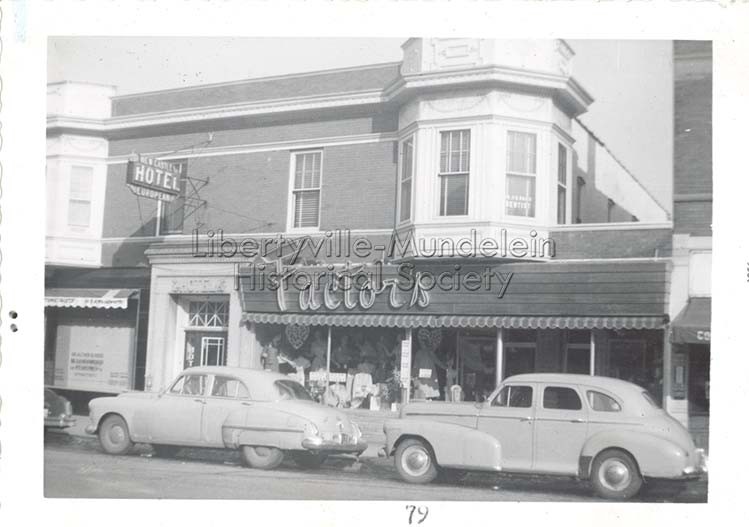
Woolworth's, 1956
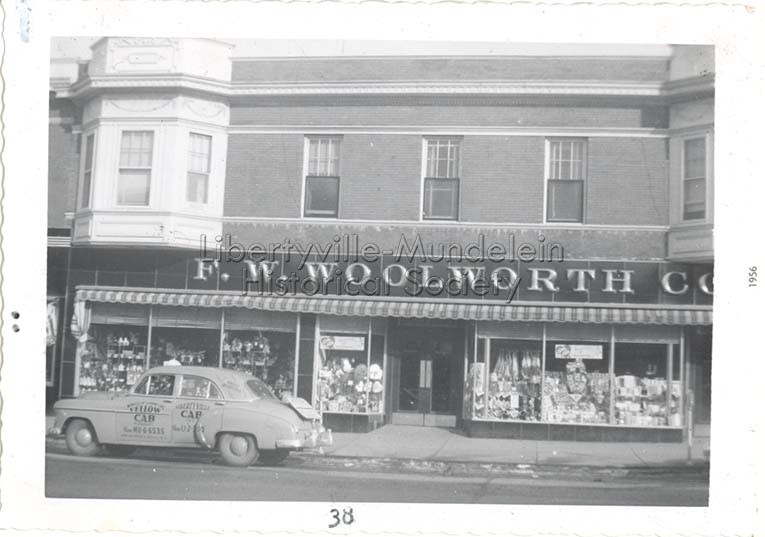
New Castle Hotel, circa 1974-1976

Backstory and Context
Text-to-speech Audio
The Proctor Building is tied to people and events that played a major role in Libertyville’s historical development. After the devastating Fire of 1895, there was a fervent campaign to rebuild Libertyville and attract economic growth. Both Robert and Elisha Proctor were part of an old land syndicate responsible for much of the growth and manufacturing that took root. In 1903 a second railroad, the Chicago North Shore and Milwaukee Railroad, was extended to Libertyville attracting commuters, businessmen and tourists. Visitors included wealthy Chicagoans eager to partake Libertyville’s major attraction at the time, curative mineral spring water. Robert, the builder behind the Proctor development, was an original founder and stockholder in the Libertyville Gravel Company and W. T. Eaton Manufacturing. He planned the Proctor business block and hotel on the site of the Grove House, an early hotel destroyed in the 1895 fire.
With 110 feet of Milwaukee Avenue footage and a stretch of plate-glass storefronts, the two-story structure was the most impressive building the town had yet erected. The Queen Anne inspired design graced the town’s main street with three-sided bays decorated with metal swags, raised panels and pediments. Facing the street a parapet with a nameplate proclaimed, “Proctor Building.” All of the building entrances and the hotel vestibule welcomed customers with mosaic tile flooring. At the back was a garden and trees. Conveniences included ventilation steam heat and modern plumbing and toilet provisions of the day.
The First National Bank, E. E. Ellsworth Grocer, W. L. Hackley Drugstore, the post office and Spellman and Morse Saloon were early tenants. Gotti’s fruit and confectionary store, the Lyric restaurant, and A. Huss Jewelers also called the Proctor Building home. In 1918 ownership of the Proctor Building passed to Elisha Proctor’s step-brother Richard Duddles and his wife Lulu. Sadly, tragedy struck the Duddles when Richard and his son were killed in an automobile accident in 1925, but Lulu carried on as owner.
Lulu initiated major changes between 1929 and 1932 with a one-story extension to the south and a two-story addition to the east that extended the back of the building fifty feet. The south extension bricked off what was a carriage way or walkway to increase and remodel commercial space for an Atlantic and Pacific Tea Store (A &P). The building’s other shops at that time, Lester’s Variety Store, Bradford Barber Shop and Ray N. Smith’s Shoes, were also completely remodeled, as well as expanded to the rear. On the second floor, the addition to the hotel contained six new three-room apartments. An inner courtyard was designed to provide windows and light to rooms otherwise darkened by a solid extension.
The 1930s introduced chain stores to the Proctor Building, first A & P in the early thirties, followed by F. W. Woolworth Company in 1935. In 1940 A & P moved to a larger building and Jewel Food Tea Store moved into their space as a third chain occupant. Between 1940 and 1948 a third addition to the rear was made on what was then Woolworth’s when the company expanded and modernized their space. Another occupant in the mid-1940s was Ray Taylor Paints and Wallpaper. After a long tenure as owner, Lulu sold the building in 1949 to a Chicago property management company, Draper and Kramer.
After 1950, a rear garage was demolished and another addition was extended north to the lot line. For the next fifty years a wide variety of shops and offices occupied the Proctor Building. The 1951 Libertyville Telephone Directory listed the following tenants: Jewel Foods, Ruttkay Jewelers and F. W. Woolworth. The following year Jewel relocated to a new store around the corner on East Cook Street. Factor’s clothing store took over the Jewel space. In the 1970s Woolworth’s permanently closed and Jamb Pharmacy moved in. Factor’s closed and Georgetown Furniture and Bedding took over their space. Jamb Pharmacy left in the 1980s and Marjen Furniture and Libertyville Jewelers later debuted. Marjen left in 1996 and the large store was redivided into its original three units.
Throughout the life of the building, the New Castle Hotel rented rooms on the second floor. When it debuted in 1903, the first-class hotel was “divided into 26 apartments for bedroom and parlor purposes, reception rooms and [a] hotel office,” according to the Lake County Independent, September 25, 1903. Milwaukee Avenue was paved in the 1920s and became a main route for automobile drivers traveling between Wisconsin and Illinois. The New Castle Hotel was a convenient stop. A 1932 expansion and the addition of six new efficiency apartments proved popular with newlyweds. The hotel began to decline in the 1950s and 1960s. George and Helen Roussakis purchased the hotel in 1967 and ran the business without significant changes. During its final years, the New Castle provided a source of inexpensive housing for public assistance recipients and others with limited incomes.
The renovation of the historic building that commenced in 1996 was created by new owners David and Sandra Whitmore and their investment team. Plans called for interior remodeling, a full restoration of the facade, code updates, conversion of hotel rooms to full apartments and reopening of the bricked-in carriage way. In the first phase of the plan, ground floor commercial spaces were remodeled for stores in the front and law offices in the back. The carriageway was opened with a twelve foot wide pedestrian passage to the rear parking lot and named Liberty Walk. The next phase of exterior restoration cleaned and tuck pointed brick and restored or reproduced trim and design features previously removed for modernization. From twenty hotel units, the Whitmores created thirteen modern one bedroom apartments with new kitchens and baths. The hotel entrance, stairway to the second floor, vestibule and upper hallways are historically unchanged. A neon sign which hung outside the building was restored and hung in a hallway. The Proctor Building merited historical integrity and was listed on the National Register of Historic Places on February 5, 1998.
Sources
520 North Milwaukee Avenue, Georgetown Furniture and Bedding, http://www.idaillinois.org/digital/collection/cookmemo11/id/6660/rec/1, circa 1974-1976, Illinois Digital Archives.
532 North Milwaukee Avenue (includes F. W. Woolworth Company), http://www.idaillinois.org/digital/collection/cookmemo11/id/6655/rec/1, circa 1974-1975, Illinois Digital Archives
Factor’s, http://www.idaillinois.org/digital/collection/cookmemo11/id/2020/rec/1, circa 1955, Illinois Digital Archives.
“Former Hotel Holds Piece of Libertyville’s Rich History” by Sharon Kutz, Daily Herald, May 26, 1998, p. 2. ProQuest, http://proquest.umi.com
Life Before the Great War - slide 5, Outside Gotti’s, http://www.idaillinois.org/digital/collection/cookmemo11/search/searchterm/life%20before%20the%20Great%20War%20slide%205, circa 1915, Illinois Digital Archives.
Life Before the Great War - slide 93, New Castle Hotel Building, http://www.idaillinois.org/digital/collection/cookmemo11/id/7795/rec/1, circa 1915, Illinois Digital Archives
Lyric Restaurant, http://www.idaillinois.org/digital/collection/cookmemo11/id/6362/rec/1, circa 1910-1915, Illinois Digital Archives.
Milwaukee Avenue Looking North, http://www.idaillinois.org/digital/collection/cookmemo11/id/876/rec/12, circa 1946, Illinois Digital Archives.
Milwaukee Avenue Looking South from School Street, http://www.idaillinois.org/digital/collection/cookmemo11/id/206/rec/3, circa 1903-1909, Illinois Digital Archives.
“More Improvements for Business District,” Libertyville Independent, October 10, 1929, p. 1.
National Register of Historic Places, Proctor Building (application). United States Department of the Interior, National Park Service, 1998.
“Newcastle Hotel Building Sold to Chicagoans,” Independent Register, July 14, 1949, p. 1.
Newcastle Hotel Restoration Renews Proctor Block History,” Lakeland Newspaper, September 20, 1996, p. 9A.
“Newcastle Renovation Underway” by Kathy Roseanne, Libertyville Review, September 19, 1996, Libertyville Review. NewsBank, http://infoweb.newsbank.com.
Proctor and First National Bank Buildings, http://www.idaillinois.org/digital/collection/cookmemo11/id/6302/rec/2, circa 1903-1910, Illinois Digital Archives.
“Proctor Building Closer to Original Look” by Kathy Rosemann, Libertyville Review, July 24, 1997, Newsbank, http://infobank.newsbank.com
“Proctor Building was in Middle of Village’s Growth” by Arlene Lane and Sonia Schoenfield, Libertyville Review, April 22, 2010, p. 19.
“Remodeling of Hotel Now Complete,” Independent Register, May 19, 1932.
“Start Work on New Addition to Building,” Libertyville Independent, August 1, 1929, p. 1.
“The New Proctor Block,” Lake County Independent Souvenir Edition, September 25, 1903.
“They Call Newcastle Home” by Jack Naudi, Libertyville Review, April 3, 1986, p. 14.
Village of Libertyville. HistoricLibertyville.com
Libertyville-Mundelein Historical Society
Libertyville-Mundelein Historical Society.
Libertyville-Mundelein Historical Society.
Libertyville-Mundelein Historical Society. Cizek Collection.
Libertyville-Mundelein Historical Society. Cizek Collection.
Libertyville-Mundelein Historical Society. Libertyville Township Assessor collection.
